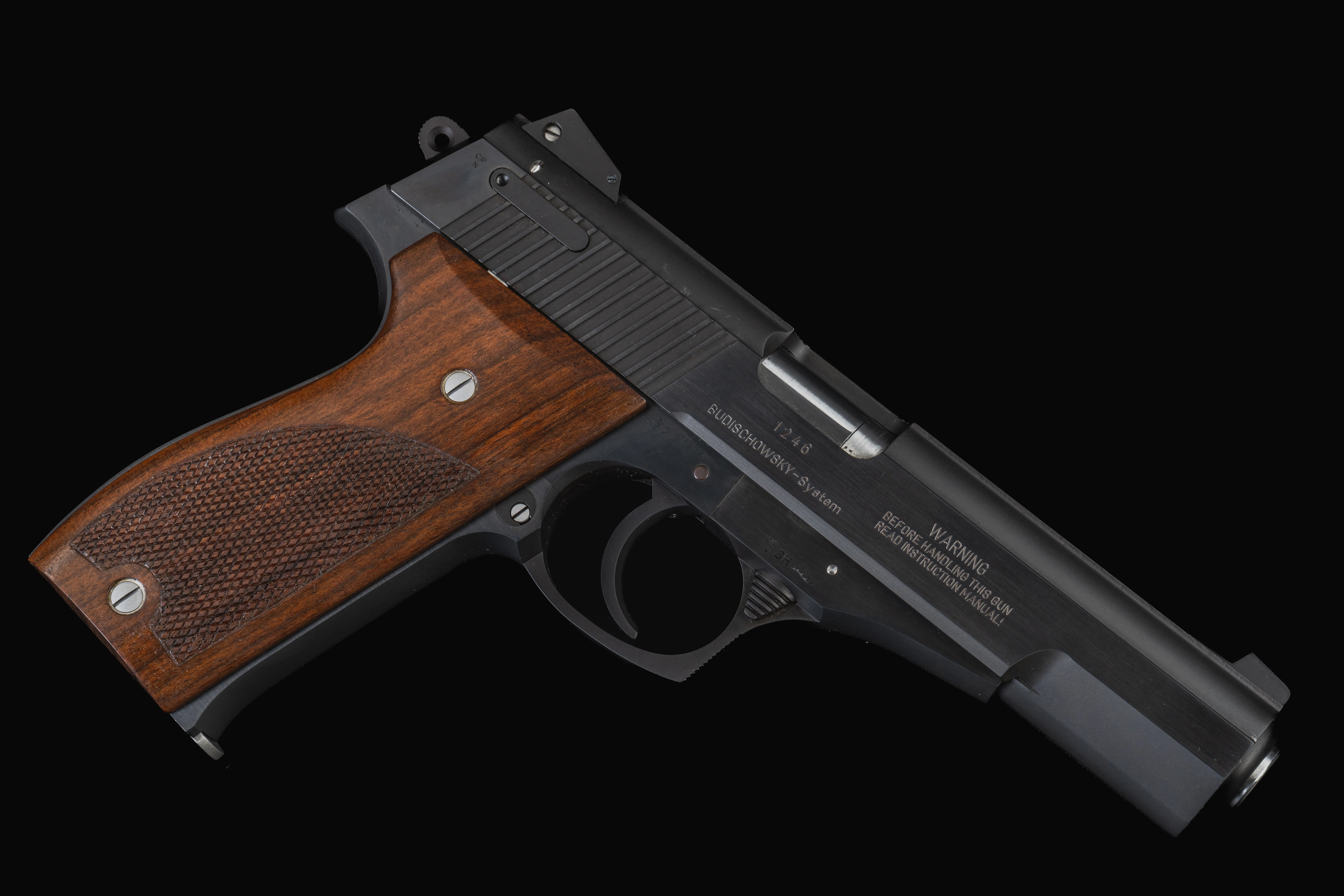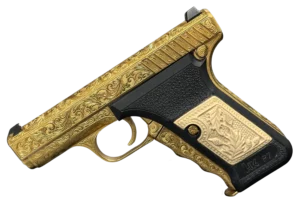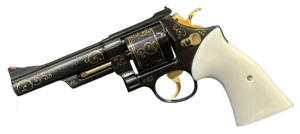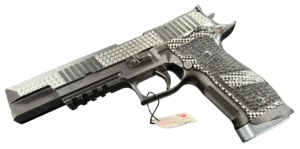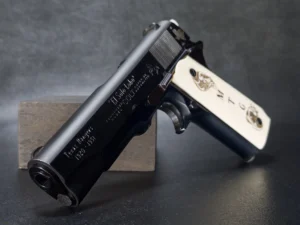Key Takeaways:
- The Korriphila HSP 701 wasn’t built for the masses — it was built for perfection: Edgar Budischowsky didn’t set out to make a duty pistol or win military contracts. He wanted to craft the finest semi-auto pistol possible, period. With fewer than 400 made, every HSP 701 is a hand-fitted, custom-built expression of that philosophy — no compromises, no shortcuts.
- It’s a mechanical marvel, and it shoots like one too: Between the roller-delayed blowback system, the fixed barrel, and that eerily smooth trigger, the HSP 701 shoots with a kind of effortlessness you don’t expect from a .45. Recoil? Tamed. Accuracy? Laser-like. You don’t just shoot this pistol — you feel every part working in sync.
- It’s rare, expensive, and worth obsessing over: With price tags now reaching five figures, the HSP 701 occupies that peculiar yet excellent space between collectible art and functional tool. It’s not practical in the modern sense — and that’s precisely the point. It’s a love letter to craftsmanship from a time when “overbuilt” wasn’t a criticism. It was the goal.
Some guns are built for war. Others for duty, defense, or sport. But now and then, a firearm comes along that exists purely because someone had to see how perfect a pistol could be — if cost, convention, and practicality were thrown out the window.
That’s the Korriphila HSP 701.
It’s not just a handgun. It’s an engineering deep-dive, a work of mechanical obsession, and quite possibly one of the most overbuilt semi-automatics ever made. If you’ve never heard of it, you’re not alone. But for those who know — collectors, hardcore shooters, and a handful of armchair gunsmiths — the HSP 701 is something close to sacred.
Let’s dive into this strange and wonderful beast.
The Man Behind the Machine
To understand the HSP 701, you’ve got to know the name Edgar Budischowsky — a Czech-born designer who moved to West Germany and, in the late 1970s, decided to build a pistol like no other.
Budischowsky wasn’t trying to supply armies. He wasn’t aiming to arm police departments or win government contracts. His mission? Create the most refined, most mechanically innovative semi-automatic pistol possible. Full stop.
In 1984, that mission became a reality with the HSP 701 — a handcrafted, low-volume, high-priced .45 ACP unlike anything else on the market.
A Gun That Doesn’t Compromise
Let’s get this out of the way: this thing isn’t just “well-made.” It’s absurdly, almost unnecessarily well-made.
Every HSP 701 starts life as a block of carbon steel. Not a casting. Not a forging. A block. Each part is machined with surgical precision and hand-fitted until there’s not a hint of rattle. No shortcuts. No stamped pieces. It’s like the Rolex of pistols — if Rolex only made 30 watches a year and every one was a different reference.
The result? A pistol that feels like one solid piece of metal. You don’t shake this gun. You handle it.
Let’s Talk About That Roller Lock
Now here’s where things get spicy.
The HSP 701 uses a roller-delayed blowback system — a nod to the same core mechanics found in legendary firearms like the HK G3 and MP5. But Budischowsky didn’t just borrow the idea — he reimagined it.
In his version, a movable breech block inside the slide locks up with the frame via rollers. When the pistol fires, the pressure pushes the slide back just enough to disengage the lock, allowing the slide to cycle. The result? Super smooth cycling. Minimal felt recoil. And a mechanical symphony you can feel with every shot.
It’s one of those things that sounds overly complicated… until you shoot it. Then it makes sense.
Fixed Barrel? Yes. Please.
Here’s another twist: the barrel doesn’t tilt. Doesn’t move at all. It’s fixed directly to the frame.
That means no shifting point of impact. No barrel wiggle. Your sights stay exactly where they were when you squeezed the trigger, and that consistency pays off in spades at the range.
It’s the kind of design choice that screams “target pistol” — but wrapped in a carry-sized package.
Clean Lines, No Clutter
In keeping with the overall “clean and perfect” vibe, the HSP 701 completely omits external safeties. It relies on internal mechanisms — a firing pin block and a hammer block — to make sure the gun won’t go bang unless you mean it.
What you do get externally is simple: a slide stop and a mag release. That’s it: no decocker, no safety lever, no clutter.
It looks sleek. Feels sleek. And once you get used to it, it’s honestly hard to go back.
Breaking It Down
Field-stripping this thing is… well, interesting.
There’s a button at the front of the trigger guard. Push it in, and you can pull the slide farther back than usual, then lift it off. It takes a bit of muscle — that recoil spring is no joke — but once you get the hang of it, it’s straightforward.
The magazine holds seven rounds of .45 ACP and looks a lot like a 1911 mag — but with the kind of hand-fitted elegance you’d expect at this level.
Shooting the HSP 701
This gun doesn’t just look good — it shoots beautifully.
At 25 yards, it’s not uncommon to see match-grade groups under three inches. We’re talking about performance that puts it on par with (or ahead of) some of the finest tuned 1911s. And it’ll digest just about anything — ball ammo, hollow points, even semi-wadcutters — without a hiccup.
That roller-delayed action does more than just smooth things out. It tames recoil. Even full-power .45 ACP loads feel manageable, and follow-up shots are fast and confident. It’s soft-shooting in a way most .45s just aren’t.
Why You’ve Probably Never Seen One
The answer’s simple: hardly anyone owns one.
Budischowsky built these guns in tiny numbers — around 30 a year — by hand. Total production? Less than 400 units.
This wasn’t mass production. It was custom watchmaker-level stuff. Each pistol was made to order, and customers could specify nearly everything: barrel length, finish, trigger type (DA/SA, SAO, DAO), sights, and caliber. You name it.
Think of it like ordering a bespoke suit, except that the suit weighs nearly three pounds and can punch holes in steel.
What It Cost Then — and What It Costs Now
Back in 1984, a brand-new HSP 701 would’ve set you back around $2,000. Which was a lot of money then — we’re talking more than a decent used car.
Today? If you can find one, expect to pay anywhere from $7,000 to $45,000, depending on the condition, configuration, and whether the stars align in your favor. These guns don’t show up often, and when they do, collectors don’t let them go easily.
The Competition (Spoiler: There Isn’t Much)
There are a few pistols that share the same lineage — the HK P7, for example, or the SIG P210. Both German. Both precision-built. Both are excellent in their ways.
But here’s the thing: the P7’s squeeze-cocker is cool, sure. The P210’s accuracy is legendary. But neither of them has the feel of the HSP 701. That weight. That roller lock. That weird, overbuilt charm.
Even Korth — the only other German manufacturer crazy enough to rival Budischowsky’s craftsmanship — approached pistol building differently. More traditional locking systems. More familiar ergonomics.
The HSP 701 stands alone. It’s weird. It’s wonderful. And it doesn’t care about fitting in.
Context Is Everything
You’ve got to remember what was happening in the gun world when this thing showed up.
The Beretta M9 was becoming the U.S. military’s new sidearm. Glock had just introduced the polymer revolution. Double-stack 9mm pistols were flooding the civilian and law enforcement markets.
And here comes Budischowsky, hand-building single-stack .45s out of steel blocks. It’s like watching someone build a Ferrari in a world suddenly obsessed with Priuses.
But that’s what makes it magical.
The Man, the Myth: Budischowsky
Before the HSP 701, Budischowsky had already made waves with the TP70 pocket pistol — a little .22/.25 that earned a cult following. But the HSP? That was his magnum opus.
This wasn’t just about building a gun. It was about perfecting it. He could’ve cut corners. He could’ve gone mainstream. But he didn’t. And we’re glad for it.
Today, Budischowsky’s name still echoes in collector circles. Not loud — but with reverence.
Is It Practical?
Honestly? Kind of.
Despite being a collectible, the HSP 701 was built to be fired. It balances beautifully. It’s easy to control. And once you understand how to strip and maintain it, it’s surprisingly straightforward to live with.
You probably won’t carry one concealed. But if you do take it to the range, it won’t disappoint.
So, What’s the Takeaway?
The Korriphila HSP 701 is what happens when a designer refuses to compromise. It’s overbuilt in the best way, and every part feels like it was made for a reason. It’s obscure, yes. But it’s also unforgettable.
In a world of plastic and polymer, something is refreshing about holding a pistol that was milled, polished, and assembled with care. No mass production. No marketing gimmicks. Just pure, unapologetic craftsmanship.
And honestly? That’s rare, even in the gun world.
Frequently Asked Questions
It’s a high-end, hand-built semi-automatic pistol designed by Edgar Budischowsky in the late 1970s and introduced in 1984. Think of it as the mechanical equivalent of a custom Swiss watch — but for people who like the smell of gun oil and the feel of blued steel.
Because it was never intended for mass production, fewer than 400 were made, and each one was built to order. No two are exactly alike, and the craftsmanship is borderline obsessive. Add in the unique roller-delay mechanism, and you’ve got a unicorn with a trigger.
It smooths out recoil in a way that feels… almost unnatural. Not soft like a .22, but controlled — more like the gun is guiding your hand rather than fighting it. It’s a system you usually see in rifles like the HK G3, so seeing it in a pistol this refined is pretty wild.
Sort of. Once you get the hang of the takedown button near the trigger guard, it’s not bad, though that recoil spring is stout. Field-stripping might not be Glock-simple, but it’s logical. And hey, if you’ve paid this much for a pistol, chances are you’re okay putting in a little effort.
Rarely — and never cheap. Prices these days range anywhere from $7,000 to $45,000, depending on condition, configuration, and collector frenzy. When one does appear, it tends to disappear quickly.


